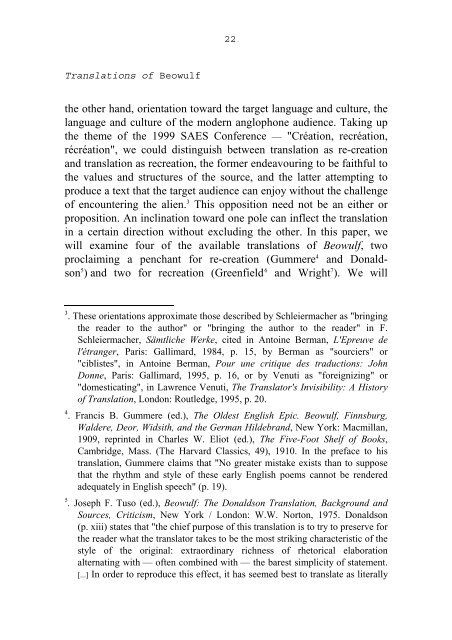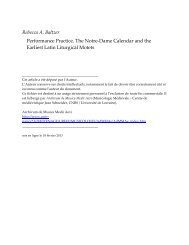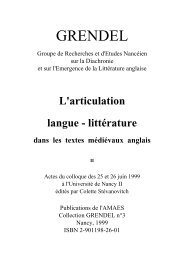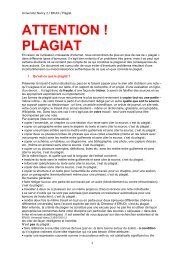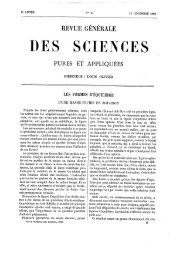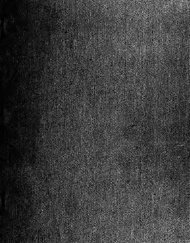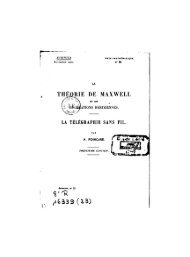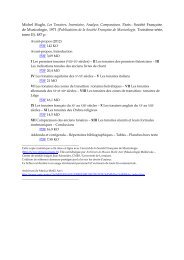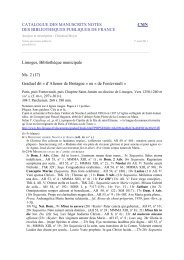3Harding-Mathieu - Université Nancy 2
3Harding-Mathieu - Université Nancy 2
3Harding-Mathieu - Université Nancy 2
Create successful ePaper yourself
Turn your PDF publications into a flip-book with our unique Google optimized e-Paper software.
Translations of Beowulf<br />
22_(12U<br />
the other hand, orientation toward the target language and culture, the<br />
language and culture of the modern anglophone audience. Taking up<br />
the theme of the 1999 SAES Conference — "Création, recréation,<br />
récréation", we could distinguish between translation as re-creation<br />
and translation as recreation, the former endeavouring to be faithful to<br />
the values and structures of the source, and the latter attempting to<br />
produce a text that the target audience can enjoy without the challenge<br />
of encountering the alien. 3 This opposition need not be an either or<br />
proposition. An inclination toward one pole can inflect the translation<br />
in a certain direction without excluding the other. In this paper, we<br />
will examine four of the available translations of Beowulf, two<br />
proclaiming a penchant for re-creation (Gummere 4 and Donaldson<br />
5 ) and two for recreation (Greenfield 6 and Wright 7 ). We will<br />
3 . These orientations approximate those described by Schleiermacher as "bringing<br />
the reader to the author" or "bringing the author to the reader" in F.<br />
Schleiermacher, Sämtliche Werke, cited in Antoine Berman, L'Epreuve de<br />
l'étranger, Paris: Gallimard, 1984, p. 15, by Berman as "sourciers" or<br />
"ciblistes", in Antoine Berman, Pour une critique des traductions: John<br />
Donne, Paris: Gallimard, 1995, p. 16, or by Venuti as "foreignizing" or<br />
"domesticating", in Lawrence Venuti, The Translator's Invisibility: A History<br />
of Translation, London: Routledge, 1995, p. 20.<br />
4 . Francis B. Gummere (ed.), The Oldest English Epic. Beowulf, Finnsburg,<br />
Waldere, Deor, Widsith, and the German Hildebrand, New York: Macmillan,<br />
1909, reprinted in Charles W. Eliot (ed.), The Five-Foot Shelf of Books,<br />
Cambridge, Mass. (The Harvard Classics, 49), 1910. In the preface to his<br />
translation, Gummere claims that "No greater mistake exists than to suppose<br />
that the rhythm and style of these early English poems cannot be rendered<br />
adequately in English speech" (p. 19).<br />
5 . Joseph F. Tuso (ed.), Beowulf: The Donaldson Translation, Background and<br />
Sources, Criticism, New York / London: W.W. Norton, 1975. Donaldson<br />
(p. xiii) states that "the chief purpose of this translation is to try to preserve for<br />
the reader what the translator takes to be the most striking characteristic of the<br />
style of the original: extraordinary richness of rhetorical elaboration<br />
alternating with — often combined with — the barest simplicity of statement.<br />
[...] In order to reproduce this effect, it has seemed best to translate as literally


